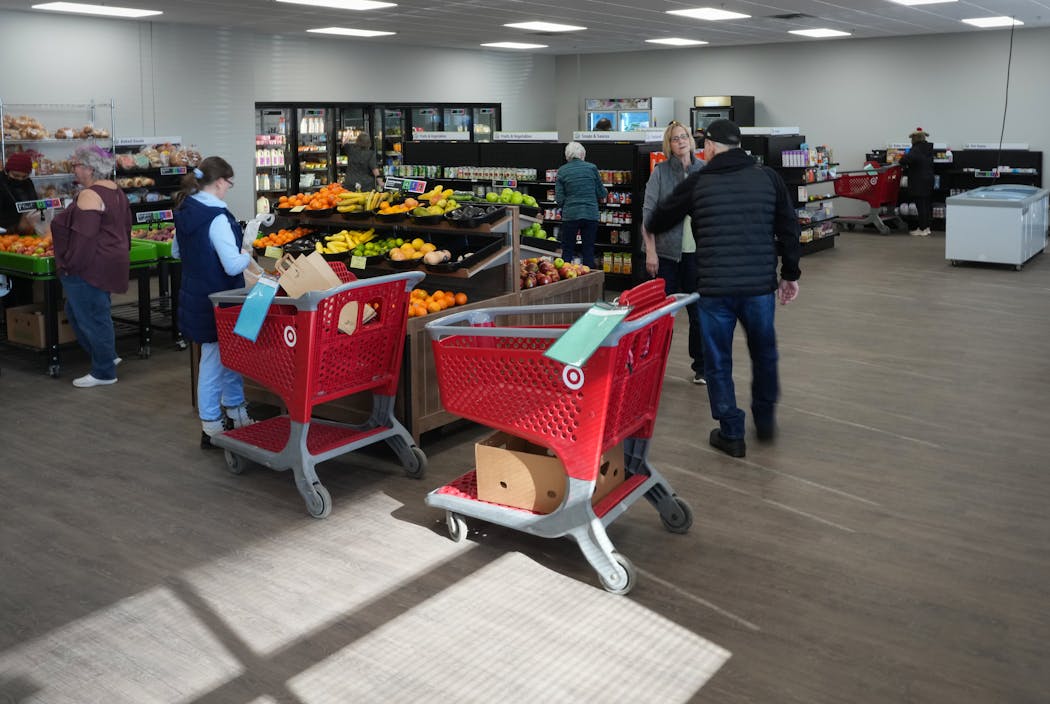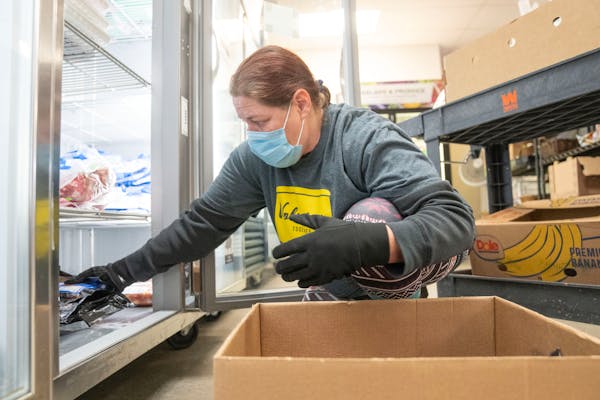The number of Minnesotans seeking help from food shelves across the state ballooned in 2022 to a record high, with new data Wednesday showing that the need for food assistance exceeded preliminary projections.
Minnesotans visited the state's food shelves more than 5.5 million times in 2022, making about 400,000 more visits than predicted last fall, according to data released by Hunger Solutions Minnesota.
That's nearly 2 million more visits to food shelves than in either 2021 or 2019 before the COVID-19 pandemic began, an increase of more than 50%.
"Although the numbers are shocking, it's fairly equally distributed across the state. There is really no one who escapes the crushing blow of poverty," said Colleen Moriarty, executive director of Hunger Solutions. "Frankly, people's incomes are not keeping pace with the cost of food."
From Forest Lake to Sandstone, food shelves issued groceries to more people who had never sought help before 2022. In Eagan, a food pantry ran out of food and had to suspend the drive-thru food distribution it started in the pandemic because so many people were showing up.
Food shelves are pressing policymakers at the State Capitol to pass legislation providing $5 million in emergency relief to the shelves. Gov. Tim Walz's budget also includes $7.7 million to food shelves in 2023.
Proposals at the Legislature last year to increase funding to the state's 470 food shelves failed. But Moriarty said advocates are optimistic this year's legislation will pass, especially given the state's record-breaking surplus of $17.5 billion.
"We know that we are actually reaching a crisis point," said Sen. Erin Maye Quade, DFL-Apple Valley, chief author of the Senate bill.
Food shelf leaders say rising inflation and the higher cost of living — coupled with the end of special financial support, from pandemic-related stimulus checks to eviction moratoriums — are forcing more people to seek free food assistance.
Next month, extra food stamp benefits issued during the pandemic are set to end, reverting back to standard amounts in April. A single person on food stamps, also known as the Supplemental Nutrition Assistance Program (SNAP), received up to $281 a month with the extra aid. The move will affect more than 200,000 households.
More Minnesotans use food stamps now than before the pandemic. In 2022, about 438,000 people on average received food stamps each month — nearly 60,000 more people than in 2019.
With food prices expected to continue to rise this year, food shelves are grappling with how to sustain the higher demand long-term.
"I am a little concerned what lays ahead of us," said Kathy Wills of Family Pathways, which operates several food shelves stretching from Forest Lake to Mille Lacs and western Wisconsin. "Where is it going to end?"
Wills said the organization hasn't seen this large of an increase in food shelf visits since 2008 amid the Great Recession. The number of new visitors alone to Family Pathways' food shelves went up 50% in 2022.
According to Hunger Solutions, the counties with the highest percentage increase in food shelf visits from 2021 to 2022 were rural: Lincoln, Faribault and Itasca. North and east metro suburbs in Washington and Anoka counties also recorded more than a 200% increase in food shelf visits.
In the south metro, Open Door's food pantry in Eagan is serving two to three times the number of people it did in 2019.
"Last year was for sure our biggest year ever," said Jason Viana, Open Door's executive director. "We're full across the board."
The Dakota County food shelf has spent three times the amount of money on food in 2022 that it did in 2021, due to increased demand and higher food costs. Open Door, which receives little government aid, has added fundraising employees to beef up donations, which jumped at the start of the pandemic but have since waned.
"When we have more help, we give more help," Viana said. "We don't expect our demand to go down."
Just this month, Open Door opened a new facility with double the space. Many people are struggling financially after crises ranging from unexpected medical expenses to costly car repairs, Viana said.
On Wednesday, people of all ages visited Open Door to pick up red potatoes, fresh vegetables and other produce. Dee Moy, 69, turned to the food pantry earlier in the pandemic when she was struggling financially. Now she gives seniors rides to the food shelf so they can pick up groceries each month.
"It will help you get through the hard times," she said. "It's a necessity if you're in need."
HOW TO GET HELP
To apply for food stamps or other benefits, go to mnbenefits.mn.gov. To see if you're eligible for food stamps or to find free meals and food shelves, go to hungersolutions.org or call the Minnesota Food HelpLine at 888-711-1151. Call 211, run by the Greater Twin Cities United Way, to be connected with food, mental health or housing assistance.

Five Minnesota political figures to watch after the 2024 election

This Minnesota county voted blue for nearly 100 years — until Trump

How Minnesota House Republicans ended the DFL's state government trifecta
Project 2025 platform proposal aims to allow mining in Boundary Waters watershed



